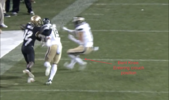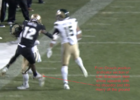Thought having a dedicated thread to rules questions could be useful.
In another thread a question was asked about the hit on Travis if it could result in a disqualification.
A: Under 9-1-1: Before the game, during the game and between periods, all flagrant fouls (Rule 2-10-3) require ejection or disqualification. Team B flagrant personal fouls require first downs if not in conflict with other rules. 2-10-3 defines a Flagrant Personal Foul as illegal physical contact so extreme or deliberate that it places an opponent in danger of catastrophic injury.
My opinion is that although the hit resulted in Travis going to the hospital, initial indications were that it was not a hit that in the referee's mind would put the player in danger of a catastrophic injury.
Furthermore under 9-6-1 all flagrant fouls that are called should automatically be reviewed by the team's conference to determine any further sanctions. If the foul is not called, a subsequent review of the game may reveal a flagrant foul and that conference may impose sanctions prior to the next scheduled game under 9-6-2.
The second situation was while I was at the game and concerned the free kick out of bounds when CU kicked from the 50. The referee initially announced the ball would be placed at the 35. I knew this was wrong, and subsequently CSU had us re-kick from the 45. The old guys in front of me didn't believe my explanation.
A: Rule 6-2-1 If a free kick goes out of bounds between the goal lines untouched by an inbounds player of Team B, it is a foul (A.R. 6-2-1-I-II and 4-2-1-III).
PENALTY—Live-ball foul. Five yards from the previous spot; or five yards from the spot where the subsequent dead ball belongs to Team B; or the receiving team may put the ball in play 30 yards beyond Team A’s restraining line at the hash mark [S19].
So because the kick went out of bounds, CSU could take the ball 5 yards from where it went out, 30 yards from the spot we kicked it, or force a re-kick 5 yards from the previous spot. So because CU kicked from the 50, and went out of bounds around the 12 yard line, they could have chosen to take the ball at the 17 (5 yards from where it went out of bounds), the 20 (30 yards from the spot of the kick), or have a re-kick at the 45 which ultimately resulted in the touchback giving them the ball at the 25. The only confusion was the referee initially announcing the ball at the 35 which was incorrect.
In another thread a question was asked about the hit on Travis if it could result in a disqualification.
A: Under 9-1-1: Before the game, during the game and between periods, all flagrant fouls (Rule 2-10-3) require ejection or disqualification. Team B flagrant personal fouls require first downs if not in conflict with other rules. 2-10-3 defines a Flagrant Personal Foul as illegal physical contact so extreme or deliberate that it places an opponent in danger of catastrophic injury.
My opinion is that although the hit resulted in Travis going to the hospital, initial indications were that it was not a hit that in the referee's mind would put the player in danger of a catastrophic injury.
Furthermore under 9-6-1 all flagrant fouls that are called should automatically be reviewed by the team's conference to determine any further sanctions. If the foul is not called, a subsequent review of the game may reveal a flagrant foul and that conference may impose sanctions prior to the next scheduled game under 9-6-2.
The second situation was while I was at the game and concerned the free kick out of bounds when CU kicked from the 50. The referee initially announced the ball would be placed at the 35. I knew this was wrong, and subsequently CSU had us re-kick from the 45. The old guys in front of me didn't believe my explanation.
A: Rule 6-2-1 If a free kick goes out of bounds between the goal lines untouched by an inbounds player of Team B, it is a foul (A.R. 6-2-1-I-II and 4-2-1-III).
PENALTY—Live-ball foul. Five yards from the previous spot; or five yards from the spot where the subsequent dead ball belongs to Team B; or the receiving team may put the ball in play 30 yards beyond Team A’s restraining line at the hash mark [S19].
So because the kick went out of bounds, CSU could take the ball 5 yards from where it went out, 30 yards from the spot we kicked it, or force a re-kick 5 yards from the previous spot. So because CU kicked from the 50, and went out of bounds around the 12 yard line, they could have chosen to take the ball at the 17 (5 yards from where it went out of bounds), the 20 (30 yards from the spot of the kick), or have a re-kick at the 45 which ultimately resulted in the touchback giving them the ball at the 25. The only confusion was the referee initially announcing the ball at the 35 which was incorrect.



